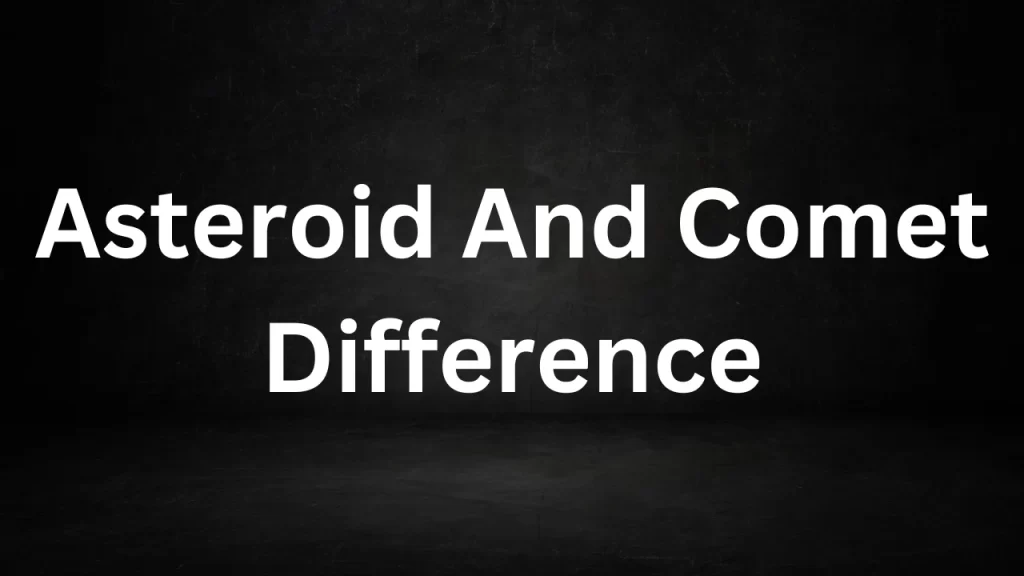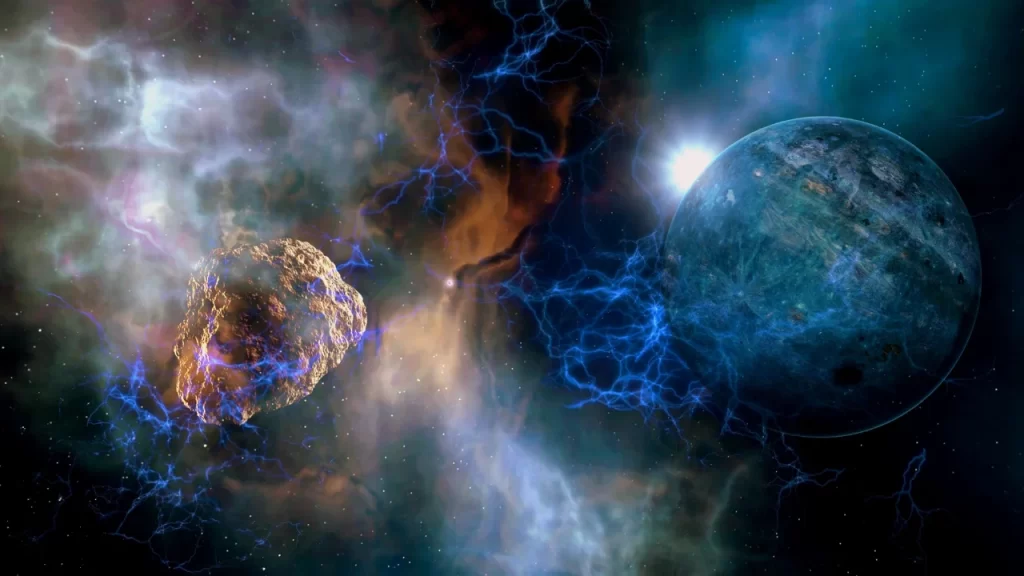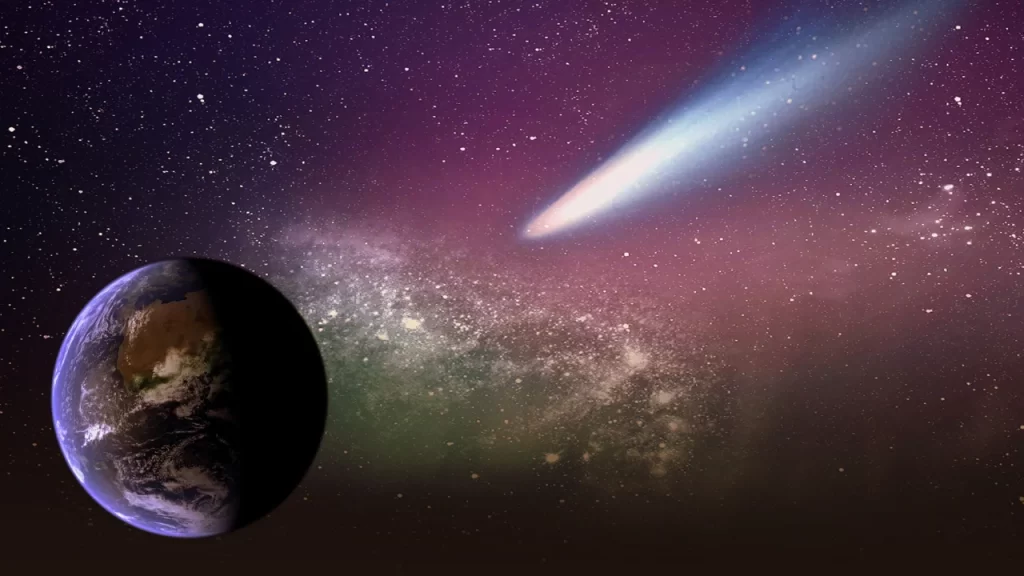Tag: meteor meteorite difference
Asteroid And Comet Difference
Asteroid And Comet Difference: Asteroids and comets are two distinct types of celestial objects that orbit the Sun, and they differ in several ways, including their composition, appearance, and behavior. Here are the key differences between asteroids and comets:

Asteroid And Comet Difference
-
Composition:
- Asteroids: Asteroids are primarily composed of rocky and metallic materials. They are often referred to as “minor planets” because they are similar in composition to the terrestrial planets like Earth.
- Comets: Comets consist of a mixture of water ice, frozen gases (such as carbon dioxide, methane, and ammonia), dust, and rocky materials. They are often called “dirty snowballs” because of their icy nature.
-
Appearance:
- Asteroids: Asteroids typically have a solid and rocky appearance. They do not develop a visible coma (a cloud of gas and dust) or a tail, and they tend to reflect sunlight like rocky surfaces.
- Comets: Comets often display a distinctive appearance when they approach the Sun. As they heat up, their ices start to sublimate, releasing gas and dust, which form a glowing coma and a tail that points away from the Sun due to the solar wind and radiation pressure.
-
Orbital Characteristics:
- Asteroids: Asteroids usually have more circular or elliptical orbits, resembling the orbits of planets. They are found primarily in the asteroid belt, a region between the orbits of Mars and Jupiter.
- Comets: Comets often have highly elliptical orbits that can take them from the distant reaches of the solar system (Oort Cloud or Kuiper Belt) to much closer to the Sun during their active phases.
-
Location:
- Asteroids: Most asteroids are found within the asteroid belt, although some may have orbits that cross Earth’s path, making them potentially hazardous near-Earth objects.
- Comets: Comets can originate from various regions of the solar system, such as the Oort Cloud (comets with long orbital periods) or the Kuiper Belt (short-period comets), and they can approach the inner solar system from these distant locations.
-
Activity:
- Asteroids: Asteroids are generally considered inactive. They do not exhibit the kinds of outgassing and tail formation that comets do when they approach the Sun.
- Comets: Comets become active when they approach the Sun, and their ices start to vaporize and release gas and dust. This activity makes them visible from Earth.
-
Size:
- Asteroids: Asteroids can vary significantly in size, from a few meters to hundreds of kilometers in diameter. Some of the largest asteroids, like Ceres, are considered dwarf planets.
- Comets: Comets are typically smaller than asteroids, with nuclei ranging from a few hundred meters to a few kilometers in diameter.


In summary, while asteroids and comets are both celestial objects in our solar system, they differ in terms of composition, appearance, orbital characteristics, location, activity, and size.
Read More
- Molecular Weight Of Nitrogen
- Molecular Weight Of NaOH
- Difference Between Force And Pressure
- Difference Between Diode And Rectifier
- Difference Between AM And FM
Frequently Asked Question (FAQs) Asteroid And Comet Difference
-
What is the fundamental difference between asteroids and comets?
The fundamental difference lies in their composition and behavior. Asteroids are primarily composed of rocky and metallic materials and do not exhibit cometary activity, such as outgassing and tail formation. In contrast, comets are composed of ice, dust, and rocky materials and display visible tails and comas when they approach the Sun.
-
Where are most asteroids and comets located in the solar system?
Most asteroids are found in the asteroid belt, a region located between the orbits of Mars and Jupiter. Comets can originate from various regions, including the Oort Cloud (long-period comets) and the Kuiper Belt (short-period comets), which are much farther from the Sun.
-
What causes the tails of comets?
The tails of comets are caused by the sublimation (vaporization) of ices in the comet’s nucleus as it approaches the Sun. Solar radiation and the solar wind push the released gas and dust away from the comet, forming a glowing coma and a tail that points away from the Sun.
-
Do asteroids ever have tails?
No, asteroids do not develop tails. They lack the icy compositions that lead to the outgassing and tail formation characteristic of comets.
-
Can comets become asteroids, or vice versa?
While both asteroids and comets can change orbits over time due to gravitational interactions, they typically retain their essential characteristics. For instance, a comet will still have its icy composition even if its orbit changes, and an asteroid will remain rocky and metallic.
Difference Between Asteroid And Meteoroid
Difference Between Asteroid And Meteoroid : Asteroids and meteoroids are celestial objects that inhabit our solar system, but they differ in several key aspects, including their size, location, and origin. Here’s a breakdown of the differences between asteroids and meteoroids:

Difference Between Asteroid And Meteoroid
1. Size:
- Asteroid: Asteroids are relatively larger celestial bodies. They can range in size from a few meters to hundreds of kilometers in diameter. Some of the largest asteroids are even classified as dwarf planets, such as Ceres.
- Meteoroid: Meteoroids are much smaller than asteroids. They can vary in size from a few millimeters to several meters in diameter. Meteoroids are typically significantly smaller than asteroids.
2. Location:
- Asteroid: Asteroids are primarily found in the asteroid belt, which is a region located between the orbits of Mars and Jupiter. However, asteroids can also be found elsewhere in the solar system, including near-Earth orbits.
- Meteoroid: Meteoroids can be found throughout the solar system. They are not confined to a specific region like the asteroid belt. Some meteoroids are part of asteroid families or are remnants of comets.
3. Composition:
- Asteroid: Asteroids are composed of various materials, including rock, metal, and sometimes even ice. Their composition can vary depending on their location and origin within the solar system.
- Meteoroid: Meteoroids can also have diverse compositions, but they are generally smaller and less massive than asteroids. Some meteoroids are composed of rock, while others may contain metal or other materials.
4. Origin:
- Asteroid: Asteroids are believed to be remnants from the early solar system’s formation, similar to planets. They are often considered leftover building blocks that never coalesced into full-fledged planets.
- Meteoroid: Meteoroids can have various origins. Some are fragments of asteroids or comets that have broken apart due to collisions or other forces. Others may be ejected material from the Moon or Mars.
5. Movement:
- Asteroid: Asteroids generally follow predictable orbits around the Sun. Their movements are influenced by gravitational forces, and they do not exhibit the rapid changes in brightness associated with meteoroids.
- Meteoroid: Meteoroids move through space at various speeds and trajectories. When they enter Earth’s atmosphere, they are often referred to as meteors or shooting stars. These meteoroids produce visible streaks of light due to their high-speed entry.
6. Visibility:
- Asteroid: Asteroids are not typically visible to the naked eye from Earth without the aid of telescopes. They remain distant and relatively stable in their orbits.
- Meteoroid: Meteoroids become visible when they enter Earth’s atmosphere and create bright streaks of light called meteors. If a meteoroid survives its journey through the atmosphere and reaches the Earth’s surface, it is referred to as a meteorite.
Read More
- Class 6 Maths Question Paper With Solutions NCERT PDF
- Sample Question Paper For Class 6 CBSE English Grammar
- NCERT Maths Book Class 6 Solutions PDF Free Download
Frequently Asked Question (FAQs) Difference Between Asteroid And Meteoroid
1. What is the main difference between asteroids and meteoroids?
The main difference between asteroids and meteoroids is their size. Asteroids are relatively larger celestial bodies, ranging from a few meters to hundreds of kilometers in diameter, while meteoroids are much smaller, typically measuring from a few millimeters to several meters.
2. Where are asteroids primarily located in the solar system?
Asteroids are primarily located in the asteroid belt, which is a region between the orbits of Mars and Jupiter. However, asteroids can also be found elsewhere in the solar system, including near-Earth orbits.
3. Do meteoroids have a specific location in the solar system like the asteroid belt?
No, meteoroids do not have a specific region in the solar system like the asteroid belt. They can be found throughout the solar system and are not confined to a particular area.
4. What are asteroids made of?
Asteroids are composed of various materials, including rock, metal, and sometimes ice. Their composition can vary depending on their location and origin within the solar system.
5. What materials are meteoroids typically composed of?
Meteoroids can have diverse compositions, but they are generally smaller and less massive than asteroids. Some meteoroids are composed of rock, while others may contain metal or other materials.